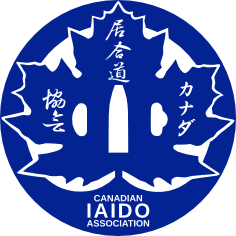Dan and Kyu Examinations
Rules Regarding Dan and Kyu Examinations
Students should be first given permission to test by their local Sensei and then they must be approved for testing by the CIA president or the CIA vice-president. The final testing is to be done at the annual seminar by the ZNIR and CIA representatives. Both the student and their Sensei should be confident that they will meet or exceed the required standard.
- Before testing for Ikkyu (1st Kyu), students should expect to practice for over 6 months, and will test with either: a Bokuto and Saya with Kurigata and Sageo, or an Iaito.
- Before testing for Shodan (1st Dan), students should expect to spend two years depending on their own progress in Iaido and be at least age 16.
- For Dan levels above Shodan there are no set time limits.
Examination Details
The examinations will consist of a practical and written examination.
After successful completion of the examination, Jyushinsha (examinees) testing for Dan will immediately receive a Temporary Certificate, followed within 6 months by the official ZNIR Dan certificate. Jyushinsha testing for Ikkyu are issued a Kyu Certificate by the Canadian Iaido Association, in recognition of their intent to test in the future with the ZNIR.
Section A: Practical Examination
The practical examination will be four waza for Ikkyu, five waza for Shodan to Sandan and six waza for Yondan to Godan.
| Testing for | 1st Waza | 2nd Waza | 3rd Waza | 4th Waza | 5th Waza | 6th Waza |
| Ikkyu (1st Kyu) | Maegiri | Mae | Battōho | Battōho | – | – |
| Shodan (1st Dan) | Maegiri | Mae | Seiza no Bu | Battōho | Battōho | – |
| Nidan (2nd Dan) | Zengogiri | Mae | Seiza no Bu | Battōho | Battōho | – |
| Sandan (3rd Dan) | Kiriage | Mae | Seiza no Bu | Battōho | Battōho | – |
| Yondan (4th Dan) | Shihogiri | Mae | Seiza no Bu | Seiza no Bu | Battōho | Battōho |
| Godan (5th Dan) | Kissakigaeshi | Mae | Seiza no Bu | Seiza no Bu | Battōho | Battōho |
The first waza must be the required Toho waza (i.e. Maegiri if you’re testing for Ikkyu or Shodan, Zengogiri if you’re testing for Nidan, etc). The second waza must be Mae from Seiza no Bu. Kaishaku is not permitted and Oikaze is not recommended.
The technique from Zen Nippon Iaido Renmei Toho will be as follows:
| Dan Level | Technique |
| Ikkyu (1st Kyu) | Maegiri |
| Shodan (1st Dan) | Maegiri |
| Nidan (2nd Dan) | Zengogiri |
| Sandan (3rd Dan) | Kiriage |
| Yondan (4th Dan) | Shihōgiri |
| Godan (5th Dan) | Kissakigaeshi |
Section B: Written Exam
The written exam may include questions about the parts of the sword, the names of waza, and the history and philosophy of Iaido. Questions will be selected from a pool of questions which you can find below.
These are the questions:
For Ikkyu (1st Kyu), questions 1, 2, 3, 4, and 5.
For Shodan (1st Dan) to Sandan (3rd Dan), questions 1, 2, 3, 4, 5, 6, and 7.
For Yondan (4th Dan) and Godan (5th Dan), questions 1, 2, 3, 5, 8, and 9.
- Write down the distinctive features of the Zen Nippon Iaido Renmei (ZNIR):
A: Our proud federation is the only Iaido specialist organization in Japan. Established in accordance with the bushido spirit, it aims to correctly transmit to future generations the time-honoured schools of kobudo Iaido.
- What is the name of your school?
Muso Jikiden Eishin-ryu (unless from different school)
- Write down the name and date of birth and death of the founder of Iaido, and the name of the location of the Iai Jinja (shrine)?
Founder: Hayashizaki Jinsuke Minamoto no Shigenobu
Date of Birth: 1542 AD
Date of Death: 1621 AD
Name of Iai Jinja: Hayashizaki Iai Jinja
Location of Iai Jinja: Tateoka, Murayama City, Yamagata Prefecture - List the five waza in Zen Nippon Iaido Renmei Toho and the schools from which they originate:
- Maegiri (Eishin ryu)
- Zengogiri (Mugai ryu)
- Kiriage (Shindomunen ryu)
- Shihōgiri (Suio ryu)
- Kissakigaeshi (Hōki ryu)
- Draw a diagram of a Japanese sword and its fittings, and name each part.
Parts of the Sword:- boshi
- fuchikane
- ha
- hamon
- ji
- kissaki
- koiguchi
- kojiri
- kurigata
- mei
- mekugi
- mekugi ana
- menuki
- monouchi
- mune
- nakago
- sageo
- saya
- seppa
- shinogi
- shinogi ji
- tsuba
- tsuka
- tsukagashira
- yokote
- List the eleven waza in Seiza No Bu.
- Mae
- Migi
- Hidari
- Ushiro
- Yaegaki
- Ukenagashi
- Kaishaku
- Tsukekomi
- Tsukikage
- Oikaze
- Nukiuchi
- List the eleven waza in Eishin-Ryu Battō Ho.
Kihon no Kata
-
- Junto sono ichi
- Junto sono ni
- Tsuigekito
- Shato
- Shihoto sono ichi
- Shihoto sono ni
- Zantotsuto
Oku no Kata
- Zenteki gyakuto
- Tatekito
- Koteki gyakuto
- Koteki nukiuchi
-
- List the ten waza in Tatehiza no bu:
- Yokogumo
- Toraissoku
- Inazuma
- Ukigumo
- Oroshi
- Iwanami
- Urokogaeshi
- Namigaeshi
- Takiotoshi
- Makko
- Explain the meaning of “Saya no Uchi” with regards to Iaido
The moment one releases the sword from the saya, with the unwavering intent to prevail, one defeats the opponent without hesitation. This, “saya no uchi”, is the heart of Iai.


